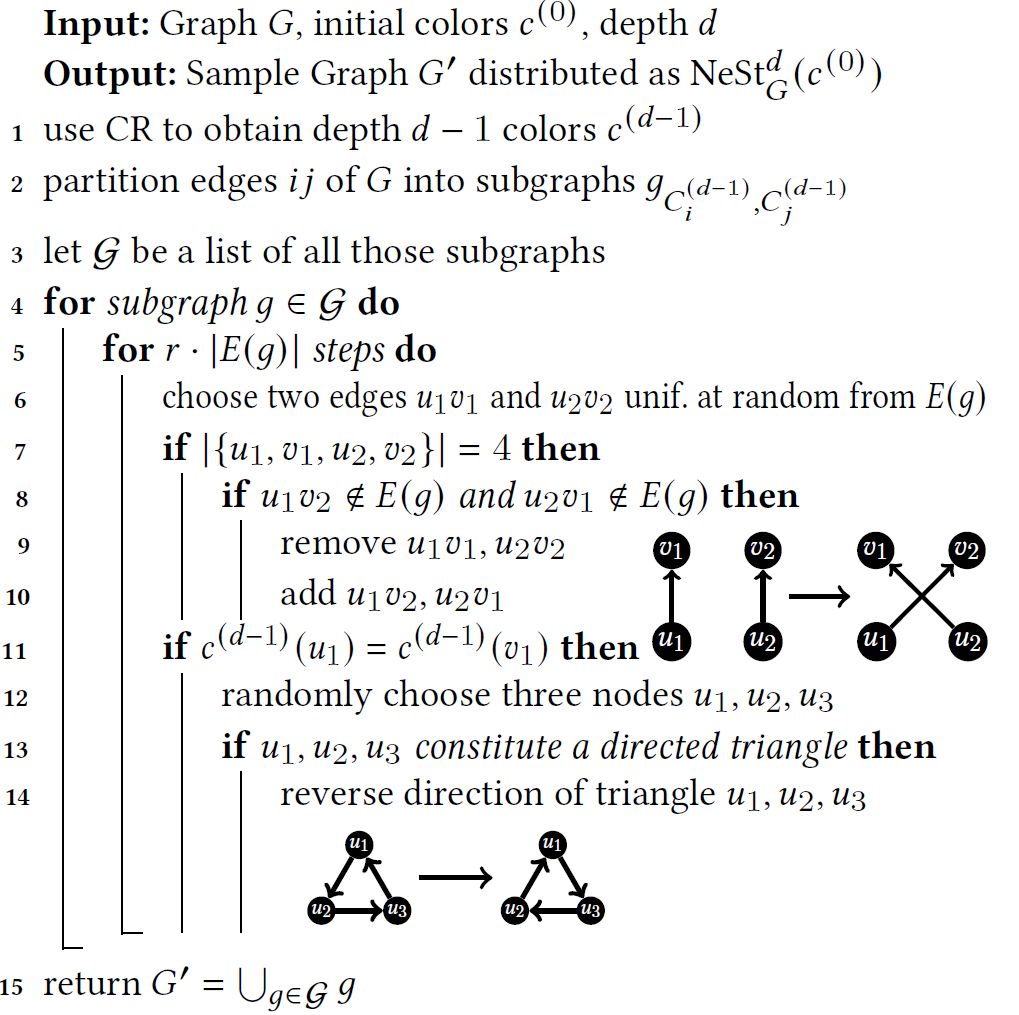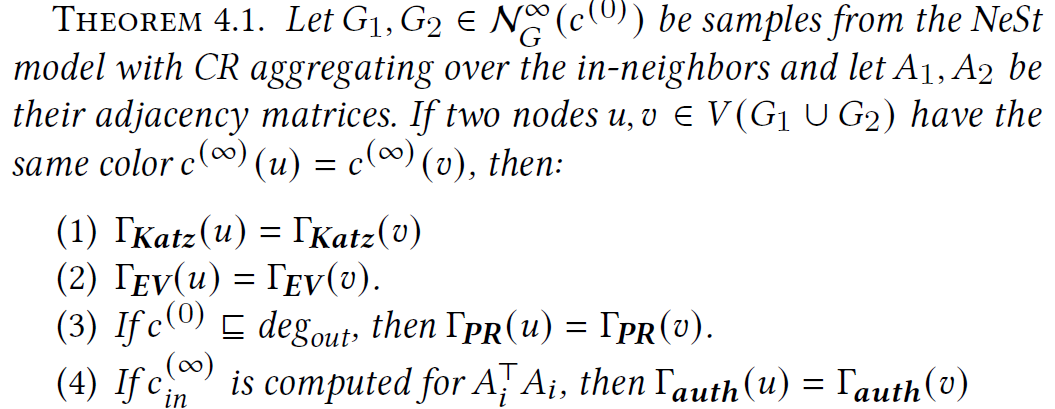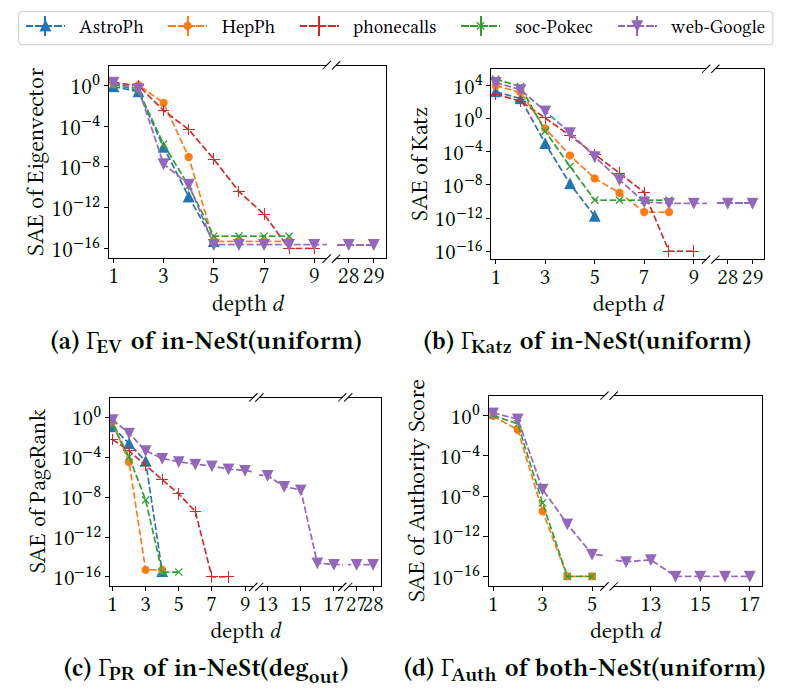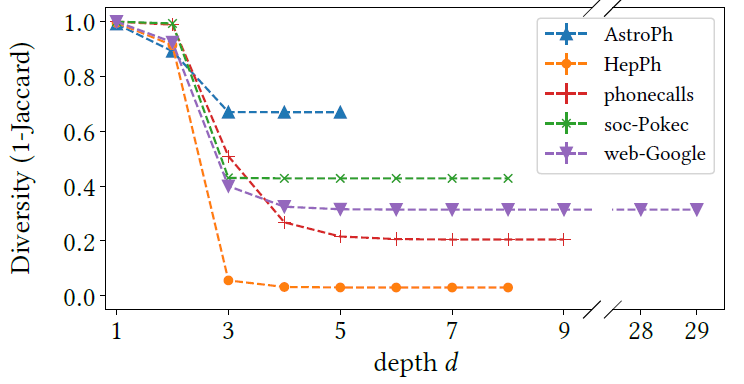[Abstract]
- sample synthetic networks that preserve the d-hop neighborhood structure
- employ a colored configuration model (color refinement algorithm)
- generated synthetic networks and the original network becomes similar (centrality measures : PR, HITS etc.)

[Introduction]
- Sampling networks with predefined properties
- limitations
- merely preserve local information
- node degrees, simple global network statistics
- ER, configuration models
- preserve certain meso cale structures and motifs, but not scalable
- exponential random graph
- merely preserve local information
- introduce “NeSt” models
- preserve mesoscale network structure
- neighborhood trees
- well-approximate centrality measures
- efficiently sample
- combine Color Refinement or Weisfeiler0Lehman algorithm with a locally Colored Configuration model
- hyperparameter: depth d → tune how eep the multi-hope neighborhood structure of each node in the original network is preserved in the null model
- preserve mesoscale network structure
- contribution: introduce $NeST^d_G (c^{(0)})$ model
- prove NeST samples exactly preserve popular centrality measure of G for an appropriate choice of $c^{(0)}$ and large d
- random graph
- ER: preserves network density on expectation
- Configuration model: degree of each node
- ERGMs: specify structures to be preserved in expectation
- Machine learning based network generators
[2. Preliminaries and Notations]
- coloring
- c1 refines c2 if c1(v)=c1(u) implies c2(v)=c2(u)
- c1 refines c2 and vice versa ⇒ c1 equals to c2
- centrality measures
- assign importance scores to nodes
- this paper focuses on “eigenvector-based centralities”

[2.1 Color refinement]
- from initial coloring $c^{(0)}$, the colors are updated by distinguishing nodes that have a different number of colored neighbors
- stop when no changes occur
-
CR procedure:

- hash: injective function from a pair onto a color space
- the colorings are iteratively refined
- once a stable partition is reached, the partition will not change
- the nodes’ colors induce an equitable partition (all nodes within one class have the same number of connections to another class)
-
extension for directed graphs

[3. The NeST Model]
- NeSt = Neighborhood Structure Configuration model
- preserves neighborhood structure information of an orignal network up to a specific depth d as encoded with the Color Refinement Algorithm
- easy to fit and sample
- hyperparameter: $c^{(0)}$ and d
- preserving the neighborhood tree structure at depth d also preserves the neighborhood structure at depth $d’\leq d$
-
noteworthy properties

- $N_G^{(d)}(const)$ implies coloring all nodes with the same color
[3.1 Sampling from the NeSt model]

- partition the edges according to the colors of their endpoints
- ex) $g_{green, red}$
- for directed graphs, $g_{green, red}$ and $g_{red, green}$ are different
- randomize each subgraph via edge swaps
- choose two edges at random and swap their endpoints with one another
- rewired as a bipartite configuration model - sampling
- MCMC
- other strategies are also fine

⇒ CR iteration doesn’t change colors
- Algorithm 1
- rewiring each subgraph independent one another

- Algorithm 2
- perform randomization one flip at a time
- more similar to other MCMCs

[3.2 Variations of the NeSt model]
- initial node colors
- if network is bipartite → reflect bipartition
- if network comprises several components → reflect the component
- if want to preserve PR → color our graph with the out-degree of the nodes
- incorporating externally defined node colors (predefined colors)
- only direct node neighboros are additionally identfied by their external color, while two-hop neighbors are not
- samples in between depth d and d+1
[4. The role of the depth parameter d]
[4.1 Maximum depth preserves centralities exactly]


[4.2 Intermediated approximates centralities]
- preserving smaller neighborhood depths is already sufficient


[5. Empeirical Illustration]
- NeST has smaller SAE, Jaccard similarity, rewire time compared to ER and ERGM.
[6. Discussion]
- preserving centralities
- focus: presrving centralities « maintaining neighborhood tree structure
- limiting the number of colors
[7. Conclusion]
- relationship with GNN
- undesirable to distinguish nodes with 1000 and 10001 neighbors